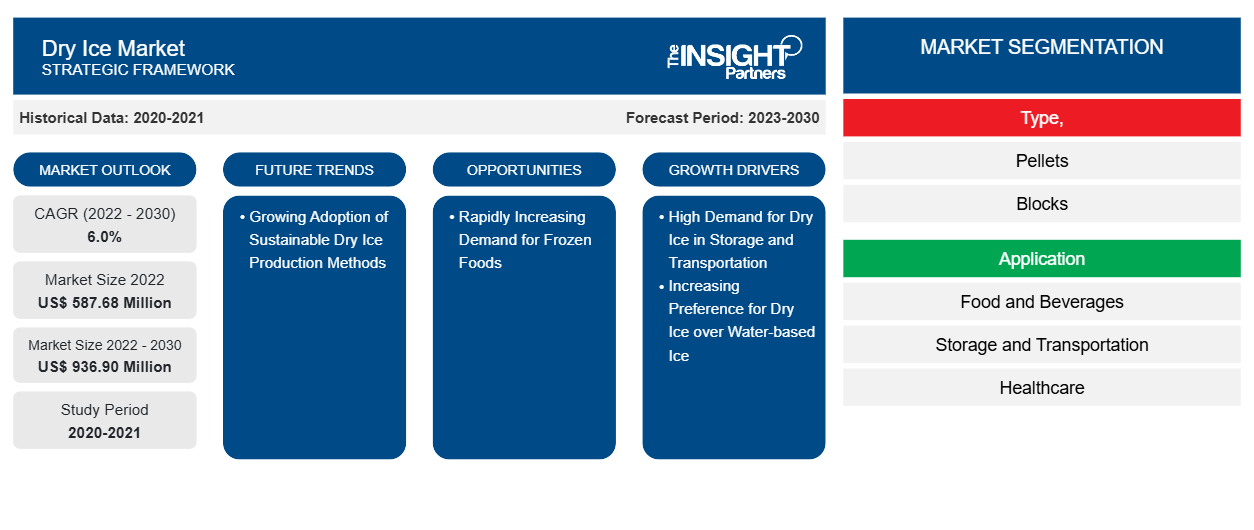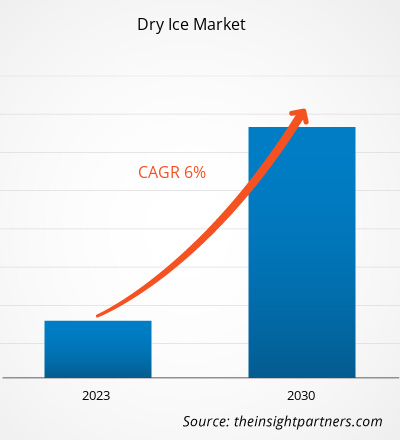[Research Report] The dry ice market size was valued at US$ 587.68 million in 2022 and is expected to reach US$ 936.90 million by 2030; it is estimated to register a CAGR of 6.0% from 2022 to 2030.
MARKET ANALYSIS
In recent years, consumers have increasingly preferred dry ice over water-based ice. The benefits provided by dry ice in the pharmaceutical, machine blasting cleaning, food preservation, and entertainment industries have led to an increased demand for dry ice over water-based ice which is driving the dry ice market growth.
Dry ice has lower temperatures than water-based ice, which has led to an increased demand for dry ice for storage and transportation applications. The lowest temperature offered by dry ice is -78°C, while the lowest offered by regular water ice is -18°C. Dry ice lasts longer than water-based ice, whereas water-based ice melts much faster and needs to be replaced to keep items cool frequently. Dry ice is being increasingly considered a far better option than water-based ice. When heated, the dry ice does not leave any residue and is also used in the production of soda and drinks. Further, dry ice is being increasingly used for transportation in the medical industry, including the transportation of body parts, organs, and blood. Thus, the increasing preference for dry ice over water-based ice is driving the growth of the dry ice market.
Dry ice has a lower temperature than water-based ice. Unlike traditional water-based ice, which melts and creates a mess as it transitions to liquid form, dry ice undergoes sublimation—transforming directly from a solid to a gas. This property eliminates the need for drainage and significantly reduces the risk of product damage or contamination during transportation and storage, making dry ice a preferred choice for various industries. In industries such as healthcare and pharmaceuticals, where precise temperature control is crucial, dry ice's ability to maintain ultra-cold temperatures is a key factor driving demand. The global distribution of vaccines, medicines, and biological samples heavily relies on dry ice for its capability to provide a consistent and extremely cold environment, ensuring the preservation of sensitive materials during transit. Additionally, the dry ice market size is likely to surge by 2030 owing to the rapidly increasing demand for frozen foods.
GROWTH DRIVERS AND CHALLENGES
The dry ice market growth is driven by the high demand for dry ice in storage and transportation and an increasing preference for dry ice over water-based ice. According to the Food and Agriculture Organization (FAO), food loss and waste cause ~US$ 940 billion per year in economic losses. While 17% of the world's food is wasted at the consumption stage, 14% is lost during the distribution, handling, and storage stages. The FAO estimates that US$ 400 billion of perishable food is wasted annually, of which half is lost due to temperature changes. Dry ice, solid carbon dioxide (CO2) at extremely low temperatures, is used extensively as a refrigerant and cooling agent in the storage and transportation sector. Its unique properties make it an indispensable tool for preserving the quality and integrity of perishable items during storage and transportation. Dry ice in the storage and transportation sector is used in the preservation of frozen and chilled products.
Further, dry ice has a lower temperature than water-based ice. Unlike traditional water-based ice, which melts and creates a mess as it transitions to liquid form, dry ice undergoes sublimation—transforming directly from a solid to a gas. This property eliminates the need for drainage and significantly reduces the risk of product damage or contamination during transportation and storage, making dry ice a preferred choice for various industries. In industries such as healthcare and pharmaceuticals, where precise temperature control is crucial, dry ice's ability to maintain ultra-cold temperatures is a key factor driving demand. However, dry ice is frozen carbon dioxide (CO2). In the dry ice manufacturing process, pure CO2 gas is first pressurized and cooled to turn it into a liquid. The liquefied CO2 is then fed into a dry ice production machine, where the pressure is released, a process that creates CO2 snow that is then compressed into pellets or blocks of dry ice. The surface temperature of dry ice is -109.3° F (-57° C). Above this temperature, dry ice sublimes, i.e., it turns directly into a gas without first becoming liquid. Dry ice cannot be stored for a long time as it sublimates within 18 to 24 hours.
Customize This Report To Suit Your Requirement
You will get customization on any report - free of charge - including parts of this report, or country-level analysis, Excel Data pack, as well as avail great offers and discounts for start-ups & universities
Dry Ice Market: Strategic Insights

-
Get Top Key Market Trends of this report.This FREE sample will include data analysis, ranging from market trends to estimates and forecasts.
REPORT SEGMENTATION AND SCOPE
The "Global Dry Ice Market Analysis and Forecast to 2030" is a specialized and in-depth study focusing significantly on global market trends and growth opportunities. The report aims to provide an overview of the global market with detailed market segmentation based on type, application, and geography. The report provides key statistics on the use of dry ice across the world, along with their demand in major regions and countries. In addition, the report provides a qualitative assessment of various factors affecting the dry ice market performance in major regions and countries. It also includes a comprehensive analysis of the leading players in the dry ice market and their key strategic developments. Analysis of the market dynamics is also included to help identify the key driving factors, dry ice market trends, and lucrative opportunities that would, in turn, aid in identifying the major revenue pockets.
The ecosystem analysis and Porter’s five forces analysis provide a 360-degree view of the global dry ice market, which helps understand the entire supply chain and various factors influencing the market growth.
SEGMENTAL ANALYSIS
The global dry ice market is segmented on the basis of type, and application. Based on type, the dry ice market is segmented into pellets, blocks, and others. In 2022, the blocks segment held the largest dry ice market share. The solid blocks of dry ice are commonly used for temporary refrigeration as carbon dioxide does not have a liquid state at normal atmospheric pressure and sublimates directly from the solid state to the gas state. Blocks of dry ice are produced in a block press. Blocks of dry ice are used in cleaning industrial equipment. It helps with the materials such as glue, ink, rubber, paint, oil, etc. The standard measurement of blocks is 10’’ x 10’’x12’’ and approximately weighs 60 lbs. Compared to pellets and slices with the same weight a dry ice block has less surface area, and it takes longer to sublimate and last longer than other forms of the same weight.
Based on application, the dry ice market is segmented into food and beverages, storage and transportation, healthcare, industrial applications, and others. In 2022, the storage and transportation segment held the largest dry ice market share. Dry ice is widely used for shipping goods. It has enhanced international trade allowing countries to export and import perishables. Products that rely on dry ice include fish, flowers, herbs, etc. Storage of perishable foods such as meat, and fish is dependent on cold storage to maintain their good conservation over time. The most efficient cold storage is to maintain the color, flavor, texture, and smell of the food products. Dry ice is also used in dry storage of stock cereals, rice, fruits, vegetables, and flour that do not require a temperature control system. Dry ice is often used as a coolant during the transportation of temperature-sensitive products due to the fact that it is colder than water ice and has no liquid phase in standard atmospheric conditions. Dry Ice can keep up with the "cool chain" all through the whole dispersion chain, from creation to end-user.
REGIONAL ANALYSIS
The report provides a detailed overview of the global dry ice market with respect to five major regions—North America, Europe, Asia-Pacific (APAC), the Middle East & Africa (MEA), and South & Central America. North America accounted for the largest share of the global dry ice market and was valued at over US$ 150 million in 2022. North America is a hub for mid-sized businesses operating in the region. The market in Europe is expected to reach over US$ 200 million by 2030. The market in North America is expected to record a CAGR of ~7% from 2022 to 2030. The growing industries such as food & beverages, healthcare, and transportation were the driving dry ice market across the region. According to Oxford Economics, in 2020, Asia Pacific held the largest share of consumer spending on eating out.
Dry Ice Market Regional InsightsThe regional trends and factors influencing the Dry Ice Market throughout the forecast period have been thoroughly explained by the analysts at The Insight Partners. This section also discusses Dry Ice Market segments and geography across North America, Europe, Asia Pacific, Middle East and Africa, and South and Central America.
Dry Ice Market Report Scope
| Report Attribute | Details |
|---|---|
| Market size in 2022 | US$ 587.68 Million |
| Market Size by 2030 | US$ 936.90 Million |
| Global CAGR (2022 - 2030) | 6.0% |
| Historical Data | 2020-2021 |
| Forecast period | 2023-2030 |
| Segments Covered |
By Type,
|
| Regions and Countries Covered |
North America
|
| Market leaders and key company profiles |
|
Dry Ice Market Players Density: Understanding Its Impact on Business Dynamics
The Dry Ice Market is growing rapidly, driven by increasing end-user demand due to factors such as evolving consumer preferences, technological advancements, and greater awareness of the product's benefits. As demand rises, businesses are expanding their offerings, innovating to meet consumer needs, and capitalizing on emerging trends, which further fuels market growth.

- Get the Dry Ice Market top key players overview
COMPETITIVE LANDSCAPE AND KEY COMPANIES
Polar Ice; Continental Carbonic Products Inc.; Sicgil India Limited.; Linde PLC; Dry Ice UK Ltd.; Dry Ice Corp; Reliant Dry Ice; CryoCab; Praxair Technology, Inc.; and ACP are among the prominent players profiled in the dry ice market report. In addition, several other players have been studied and analyzed during the study to get a holistic view of the market and its ecosystem. The dry ice market report also consists of company positioning and concentration to evaluate the performance of competitors/players in the market.
INDUSTRY DEVELOPMENTS AND FUTURE OPPORTUNITIES
Some initiatives taken by the key players operating in the dry ice market are listed below:
- In May 2021, Continental Carbonic Products, Inc. (CCPI) is opened a liquid carbon dioxide (CO2) and dry ice manufacturing facility in El Dorado, Arkansas, US.
- In August 2021, Award-winning Portarlington company gets green light for expansion.
Frequently Asked Questions
By type, which segment accounted for the largest share in the global dry ice market in 2022?
Which application segment is the fastest growing in the global dry ice market?
What is the key driver for the growth of the global dry ice market?
In 2022, which application held the largest market share in global dry ice market?
In 2020, which region held the largest share of the global dry ice market?
Can you list some of the major players operating in the global dry ice market?
- Historical Analysis (2 Years), Base Year, Forecast (7 Years) with CAGR
- PEST and SWOT Analysis
- Market Size Value / Volume - Global, Regional, Country
- Industry and Competitive Landscape
- Excel Dataset
Recent Reports
Testimonials
Reason to Buy
- Informed Decision-Making
- Understanding Market Dynamics
- Competitive Analysis
- Identifying Emerging Markets
- Customer Insights
- Market Forecasts
- Risk Mitigation
- Boosting Operational Efficiency
- Strategic Planning
- Investment Justification
- Tracking Industry Innovations
- Aligning with Regulatory Trends





















 Get Free Sample For
Get Free Sample For